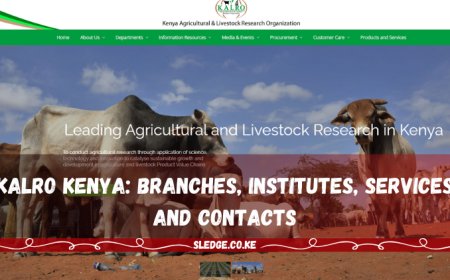New NSSF Rates 2024 For Tier I and Tier II contributions, deadlines, and interest rates.
Explore the essential details of Kenya's New NSSF Rates for 2024. Understand the impact on employers and employees, and learn about Tier I and Tier II contributions, deadlines, and interest rates.

Welcome to our comprehensive guide on the New NSSF Rates effective February 2023 in Kenya. The National Social Security Fund (NSSF), a crucial pillar in Kenya's social security framework, has undergone significant changes that impact employers and employees nationwide. This article aims to demystify these changes, particularly focusing on introducing Tier I and Tier II contributions, a pivotal shift in how Kenyans contribute to their retirement savings. Whether you're an employee wondering about your new deduction rates or an employer seeking to understand your updated obligations, this guide provides essential insights into the revamped NSSF structure. Join us as we delve into the details of these changes, their historical context, and what they mean for your financial planning and security.
Overview of New NSSF Rates
Understanding the New NSSF Contribution Structure
The National Social Security Fund (NSSF) has revised its contribution rates in a significant policy shift. Starting February 2023, the NSSF contribution rate was 12% of pensionable wages. This amount is equally shared between the employer and the employee, with each contributing 6%. This change represents a substantial increase in NSSF contributions to bolster retirement funds for Kenyan workers.
The new NSSF rates vary according to an employee's pensionable earnings. The rates range from KES 360 to KES 2,160, as outlined in the following detailed table. This table reflects the varying contributions based on different salary brackets, providing a clear picture of how much employees and employers need to contribute at each level of earning.
This updated contribution framework is designed with an Upper Earning Limit (UEL) of KES 18,000 and a Lower Earning Limit (LEL) of KES 6,000. These limits are crucial in determining the contributions under the Tier I and Tier II classifications. The division into these two tiers is a pivotal aspect of the new system, aimed at accommodating the diverse earning scales in the Kenyan workforce.

Historical Context and Recent Changes
To understand the current changes, looking back at the history of NSSF contributions in Kenya is essential. The National Social Security Fund Act, Cap 258 of 1965, governed the contributions, setting the deduction at Ksh. 200 for a long period. However, on December 24, 2013, amendments to the Act were proposed, leading to the current changes.
The path to these new rates has been complex. The proposed changes faced legal challenges, with the Kenya Plantations & Agricultural Workers' Union contesting them in court. It wasn't until 2023, following a Court of Appeal decision, that the government was authorized to implement the new contribution rates. This legal clearance has paved the way for the increased rates today.
Tier I and Tier II Contributions Explained
Tier I vs. Tier II - What's the Difference?
In the new NSSF regime, understanding the distinction between Tier I and Tier II is crucial. The fundamental difference lies in the salary brackets. Tier I contributors earn KES 6,000 and below per month, while Tier II contributors are in the higher earning bracket of KES 18,000 and above per month. For Tier I, the maximum contribution is KES 720, whereas Tier II has a higher cap of KES 1,440.
These two tiers represent a strategic approach by the NSSF to accommodate the diverse income levels of Kenyan workers. This differentiation ensures that contributions are proportional to earnings, making the system more equitable and sustainable.
Practical Examples of How the New Rates Affect Salaries
Let's consider some practical examples to clarify how these rates apply. For employees earning under KES 6,000 (Tier I), the monthly contribution will be KES 360, matched by the employer, totaling KES 720. On the other hand, those earning above KES 18,000 (Tier II) will contribute KES 720 each (employee and employer), totaling KES 1,440 per month.
It's essential to note that there is a ceiling limit for contributions. The minimum contribution under the new rates is KES 720, while the maximum is KES 2,160. This cap ensures that contributions remain within a reasonable range relative to employees' salaries.
Employer and Employee Obligations
Employer Responsibilities Under the New Rates
With the new NSSF rates, employers in Kenya face additional responsibilities. Key among these is ensuring a 6% deduction from their workers' pensionable earnings, matched by a similar contribution from their side, totaling 12%. Moreover, all businesses with more than one employee must register as contributing employers with the NSSF. Timely payment is crucial as late contributions attract penalties, and maintaining accurate records of employees' earnings is mandatory. Failure to comply with these stipulations is considered a criminal offense, potentially leading to prosecution.
Employee Rights and Responsibilities
Employees also have a role to play under the new NSSF framework. They must provide accurate and up-to-date information for registration and be aware of their social security rights. Understanding these rights is vital, and resources such as the NSSF guidebook, available online, can be immensely helpful. Employees should also ensure that their employers deduct the correct amounts, as the new rates stipulate.
Additional Information and Tools
Tools for Calculating NSSF Contributions
In today's digital age, calculating NSSF contributions has become easier. Thanks to user-friendly online calculators, employees can now determine the correct salary deductions. These tools are useful for ensuring employers' compliance and for voluntary contributors managing their funds. Enter your gross salary, and the calculator takes care of the rest. For any queries or clarifications, the NSSF offices are readily accessible, including through their social media platforms.
Interest Rates and Returns on NSSF Savings
An important aspect of the NSSF is the interest rate on savings, which currently stands at approximately 6.87% per year. This rate has been effective since 2018 and significantly increases the value of retirees' savings. The rise in interest rates results from the NSSF's strategic investments, including dividends from major companies and government treasury bonds, enhancing the fund's capacity to support its members in their post-employment years.
FAQ Section
What is the deadline for NSSF payments?
- NSSF payments are due before the 9th of each month. Late payments attract penalties.
Are all employees in Kenya required to contribute to the NSSF?
- Yes, according to Section 18 of the NSSF Act of 2013, all employed persons in Kenya over 18 years must be members of the Pension Fund and contribute according to the prevailing rates.
How has the interest rate on NSSF savings changed over the years?
- The interest rate on NSSF savings has been approximately 6.87% annually since 2018, reflecting a steady increase from previous years due to the fund's investment income.
READ ALSO: How to Apply for a Good Conduct Certificate in Kenya
Conclusion
In conclusion, the New NSSF Rates implemented in Kenya from February 2023 mark a significant shift in the country's social security landscape. These changes, encompassing Tier I and Tier II contributions, are designed to enhance the retirement benefits for Kenyan workers. Employers and employees must be well-informed about their obligations and rights under the new system. With tools to calculate contributions and an understanding of the interest rates on savings, individuals can better manage their financial future. Staying informed and compliant is key to making the most of these changes.




































































![Top internet service providers in Kenya[2024]: Comparison of Services, Speeds, and Pricing](https://sledge.co.ke/uploads/images/202304/image_380x226_644e2b2f7f6db.jpg)







